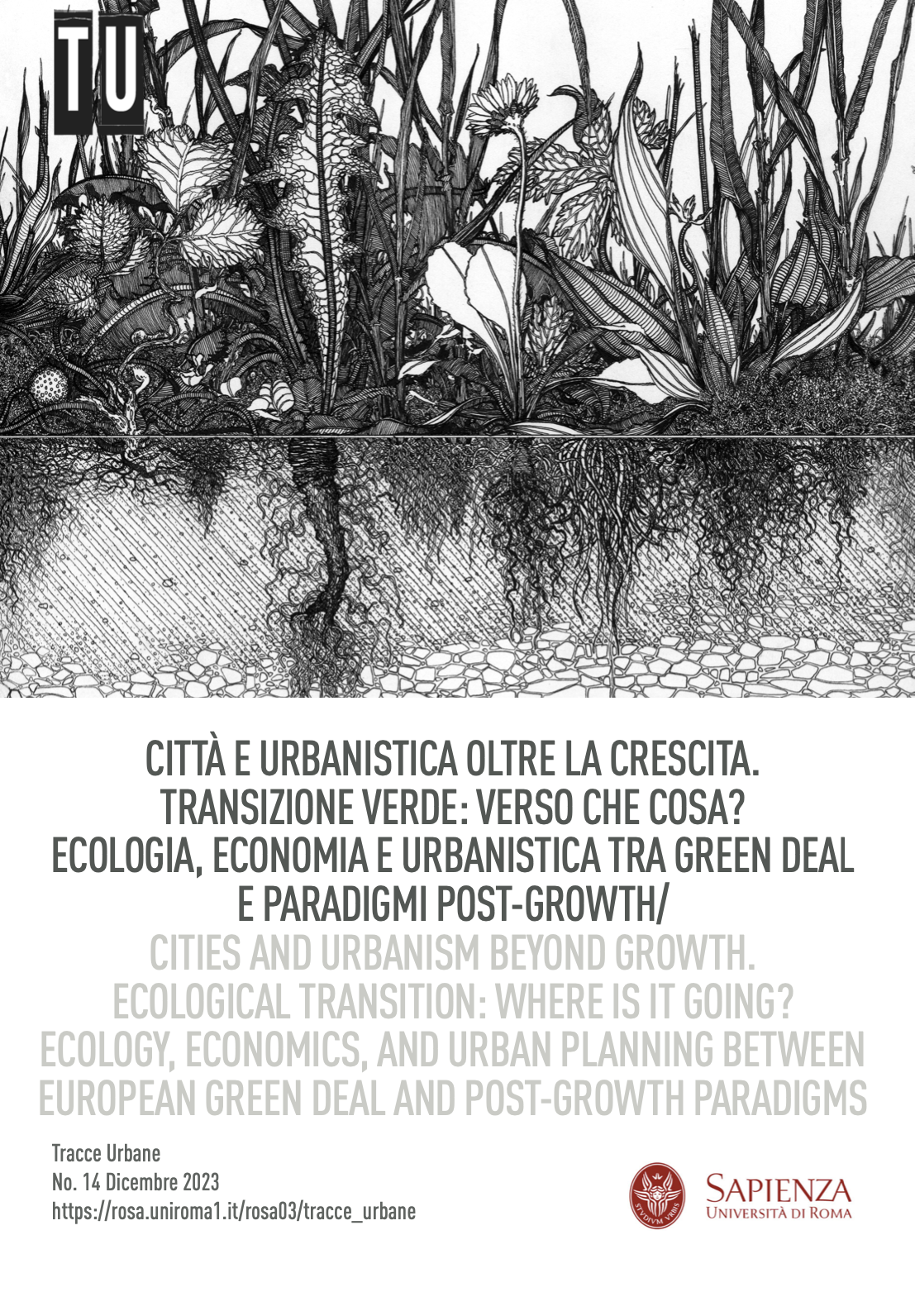Heterotopias of transition
Notes from a research program
DOI:
https://doi.org/10.13133/2532-6562/18631Parole chiave:
transizione ecologica, eterotopie, pre-emption e preparednessAbstract
Ecological transition is generally seen to ask for profound changes. The city condenses many aspects of the issue, not least the variety of spatial and temporal scales involved. The article examines different declinations of the concept of change and the relationship between space and time that they entail. The issue is placing this relationship in the context of modern space-time topology. This has recently seen new anticipatory approaches come to the fore, that abandon the linearity of the relationship between present and future in favour of recursive structures centred on eschatological, catastrophic or regenerative visions. Such emerging topologies, which would seem to evoke the traditional concepts of utopia and dystopia, are examined in the light of the notion of heterotopia formulated by Foucault, with which they share much while contradicting its transgressive scope, its ability to open up at once to the elsewhere and the otherwise. The question is how to think transition in heterotopic terms. Some current experiences can be read as heterotopias, but we need to develop the ability to distinguish heterotopias from ‘autotopias’, which are designed to prevent any real change.
Riferimenti bibliografici
Agamben G. (2005). The time that remains: a commentary on the Letter to the Romans. Stanford, CA: Stanford University Press.
Anderson B. (2010). «Preemption, precaution, preparedness: anticipatory action and future geographies». Progress in Human Geography, 34(6): 777–798.
Baker S. (2019). «Novel ecosystems and the return of nature in the Anthropocene». In: Arias-Maldonado, M., Trachtenberg, Z., eds., Rethinking the environment for the Anthropocene. London: Routledge, pp. 51-64.
Bonaiuti M. (2018). «Are we entering the age of involuntary degrowth? Promethean technologies and declining returns of innovation». Journal of Cleaner Production, 197(2): 1800-1809.
Cassegard C., Thörn H. (2018). «Toward a postapocalyptic environmentalism? Responses to loss and visions of the future in climate activism». Environment and Planning E, 1(4): 561-578.
Engler N., Krarti M. (2021). «Review of energy efficiency in controlled environment agriculture». Renewable and Sustainable Energy Reviews, 141(110786) [online]. doi:10.1016/j.rser.2021.110786.
EEA (2022). Energy prosumers and cities. EEA Briefing no. 19/2022. Copenhagen: European Environment Agency.
Foucault M. (1986). «Of other spaces». Diacritics, 16(1): 22-27.
Foucault M. (2007). Security, territory, population. Lectures at the Collège de France, 1977-1978. New York: Palgrave MacMillan.
Greimas A. (1984). Structural semantics. Lincoln, NE: University of Nebraska Press.
Hacking I. (1990). The taming of chance. Cambridge: Cambridge University Press.
Israel G. (2004). La macchina vivente. Contro le visioni meccanicistiche dell’uomo. Torino: Bollati Boringhieri.
Kaiser M. (2015). «Reactions to the future: the chronopolitics of prevention and preemption». Nanoethics, 9: 165-177.
Keck F. (2020). Asian reservoirs. Durham, NC: Duke University Press.
Koselleck R. (2002). «The temporalization of utopia». In: Id., The practice of conceptual history: timing history, spacing concepts. Stanford, CA: Stanford University Press, pp. 84-99.
Lakoff A. (2017). Unprepared. Global health in a time of emergency. Oakland, CA: University of California Press.
Luhmann N. (1976). «The future cannot begin: temporal structures in modern society». Social Research, 43(1): 130-152.
Massumi B. (2007). «Potential politics and the primacy of pre-emption». Theory & Event, 10(2). [online]. doi: 10.1353/tae.2007.0066.
Monticelli L., ed. (2022). The future is now. An introduction to prefigurative politics. Bristol: Bristol University Press.
Mucchielli L. (2020). «Behind the French controversy over the medical treatment of Covid-19: the role of the drug industry». Journal of Sociology, 56(4): 736-744.
OECD (2020). Strengthening agricultural resilience in the face of multiple risks. Paris: OECD.
Oxfam (2020). Confronting carbon inequality. Nairobi: Oxfam International.
Pellizzoni L. (2009). «Revolution or passing fashion? Reassessing the precautionary principle». International Journal of Risk Assessment and Management, 12(1): 14-34.
Pellizzoni L. (2020). «The environmental state between pre-emption and inoperosity». Environmental Politics, 29(1): 76-95.
Pellizzoni L. (2023). Calvalcare l’ingovernabile. Natura, neoliberalismo e nuovi materialismi. Napoli-Salerno: Orthotes.
Pellizzoni L., Sena B. (2022). «Preparedness as governmentality. Probing the Italian management of the Covid-19 emergency». Sociologica, 15(3): 61-83.
Shir-Raz Y., Elisha E., Martin B., Ronel N., Guetzkow J. (2022). «Censorship and suppression of Covid-19 heterodoxy: tactics and counter-tactics». Minerva [online]. doi: 10.1007/s11024-022-09479-4.
Thacker E. (2007). The global genome. Cambridge, MA: MIT Press.
Vatistas C., Avgoustaki D.D., Bartzanas T. (2022). «A systematic literature review on controlled-environment agriculture: how vertical farms and greenhouses can influence the sustainability and footprint of urban microclimate with local food production». Atmosphere, 13(1258) [online]. doi: 10.3390/atmos13081258.
Virno P. (1996). «Virtuosity and revolution: the political theory of exodus». In: Virno, P., Hardt, M., eds., Radical thought in Italy: a potential politics. Minneapolis: Minnesota University Press, pp. 189-212.
Wallace R. (2016). Big farms make big flu: dispatches on influenza, agribusiness, and the nature of science. New York: Monthly Review.
Walzer M. (1985). Exodus and revolution. New York: Basic Books.
WHO (2009). Pandemic influenza preparedness and response: a WHO guidance document, Geneva, World Health Organization.
##submission.downloads##
Pubblicato
Come citare
Fascicolo
Sezione
Licenza
Copyright (c) 2024 Luigi Pellizzoni

TQuesto lavoro è fornito con la licenza Creative Commons Attribuzione 4.0 Internazionale.
NOTA DI COPYRIGHT
Proposta di licenza Creative Commons
1. Proposta per riviste Open Access
Gli autori che pubblicano su questa rivista accettano le seguenti condizioni:
Gli autori mantengono i diritti sulla loro opera e cedono alla rivista il diritto di prima pubblicazione dell'opera, contemporaneamente licenziata sotto una Licenza Creative Commons - Attribuzione che permette ad altri di condividere l'opera indicando la paternità intellettuale e la prima pubblicazione su questa rivista.
Gli autori possono aderire ad altri accordi di licenza non esclusiva per la distribuzione della versione dell'opera pubblicata (es. depositarla in un archivio istituzionale o pubblicarla in una monografia), a patto di indicare che la prima pubblicazione è avvenuta su questa rivista.
Gli autori possono diffondere la loro opera online (es. in repository istituzionali o nel loro sito web) prima e durante il processo di submission, poiché può portare a scambi produttivi e aumentare le citazioni dell'opera pubblicata (Vedi The Effect of Open Access).


